Today is the final day of the Domitor 2016 conference in Stockholm. This international conference for film historians bulks of interesting lectures, panels, round tables and screenings, all on the early cinema. The film programme includes early shorts made before World War I by the French studio Pathé Frères. So especially for our favourite film historian who does a presentation today in Stockholm, EFSP presents 12 dazzling but very old postcards of early Pathé shorts.
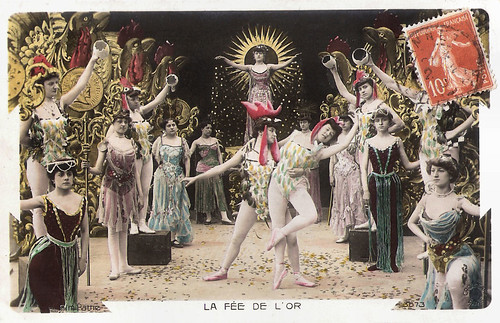
French postcard by Croissant, Paris, no. 3573. Photo: Film Pathé. This is the final scene from La poule aux oeufs d'or (Gaston Velle 1905), adapted from the fable of Jean de la Fontaine. Cinematography and special effects by Segundo de Chomón.
A poor farmer wins a chicken in the lottery at the fairground. The chicken is an enchanted animal (doing a chicken dance with the other chicken girls), laying big eggs full of money. Thieves whom we already saw 'working' at the fairground, steal rabbits from the farmer. The farmer turns a rich man, but his wealth is short-lived. The thieves steal an egg but a bat flies out of it. Another egg contains a devil spitting gold and it explodes. At night the thieves witness how the farmer takes an egg to a secret cellar where he cherishes all his gold, despite nightmare visions of staring eyes and grabbing arms. After the thieves have stolen the money the creditors appear. Desperately, and inspired by a devil, the man slaughters the chicken. He finds a last egg but an evil witch comes out of it who sends him to a fairyland. There the man is led away, after which an apotheosis follows with a dance of chicken girls and fairies, emptying eggs with gold coins.
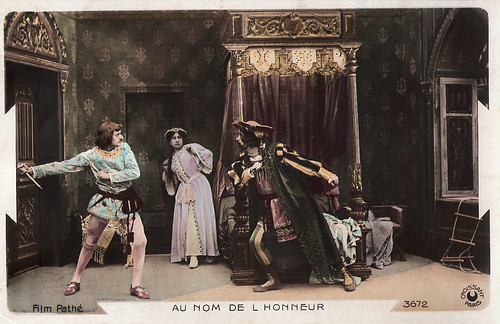
French postcard by Croissant, Paris, no. 3672. Photo: Film Pathé. Publicity still for Un drame à Venise/Venetian Tragedy (Lucien Nonguet, 1906). Sent by mail in 1917.
In this early Pathé Frères production, one of the rich palaces of Venice is the setting for a drama of smouldering love and hate. In the Middle Ages, an important lord is not loved by his wife. Despite the sumptuous wealth her husband surrounds her with, the noble dame can only think about a young and handsome Romeo. The lover is surprised by the husband, who kills him and Romeo ends in a canal. The noble lady escapes her death when her husband is stopped by her miraculous beauty... The film is partly in colour.
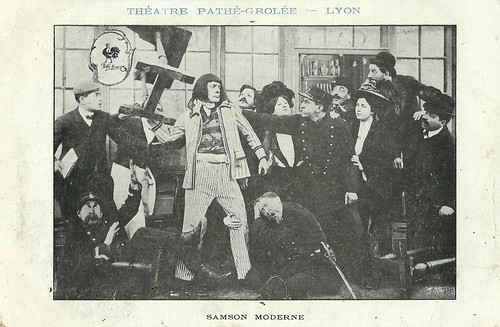
French postcard by Théâtre Pathé Grolée, Lyon. Photo: Pathé Frères. Publicity still for Samson moderne (N.N., 1908).
On the fairground an unknown young man manages to conquer the wrestling champion. When after a series of adventures he is imprisoned he breaks down the walls like a modern Samson. Returned home his wife celebrates him with wine but is jealous of his force, so like a modern Delila she cuts his hair off in his sleep. Awakened, the man has lost his hair and his strength.
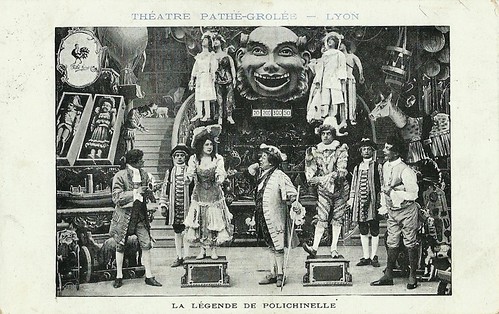
French postcard by Théâtre Pathé Grolée, Lyon. Photo: Pathé Frères. Publicity still for La légende de Polichinelle (Albert Capellani, 1907). With Max Linder as Polichinelle.
Polichinelle is an automaton in love with a cute doll in the same shop. When the doll is sold, a fairy helps Polichinelle following her and after a series of wild adventures he arrives at the house of the buyer just in time to save the doll from being burned.
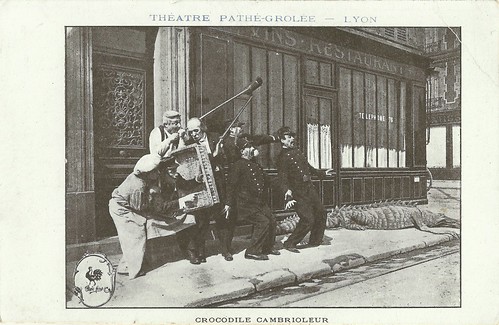
French postcard by Théâtre Pathé Grolée, Lyon. Photo: Pathé frères. Publicity still for Un crocodile cambrioleur (N.N., 1908).
Two burglars are interrupted in their job, so one hides underneath a crocodile skin. The old professor sees the dead animal moving and alarmed he leaves to find his gun. The 'reptile' flees but is hunted by the professor and his shotgun. An ever growing multitude follows the crocodile on the street. Finally the thief mounts a pipe and frightens a family taking tea, profiting from their flight to steal valuable objects, and exiting the same way as he came. Meanwhile, the mass outside shows up while our man takes off his skin. The professor shoots and all are surprised when they find just the skin and the thief gone.
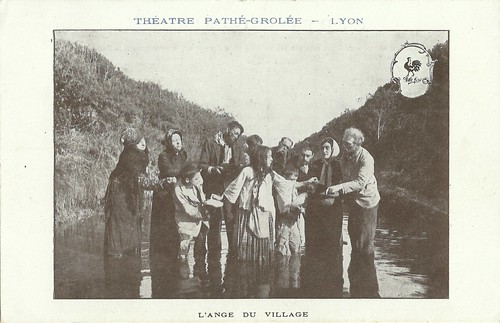
French postcard by Théâtre Pathé Grolée, Lyon. Photo: Pathé Frères. Publicity still for L'ange du village (N.N., 1908).
A young girl who begs for money to help her deadly sick mother, witnesses her mother's death and goes berserk. Everywhere she goes she sees beggars whom she gives money: even in a river. She wanders fields and woods. Suddenly she sees her mother with her arms spread... and falls dead on the road.
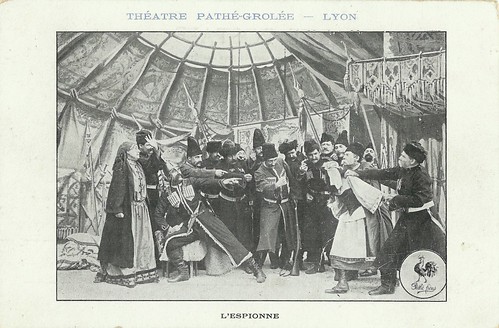
French postcard by Théâtre Pathé Grolée, Lyon.Photo: Pathé Frères. Publicity still for L'Espionne (N.N., 1906). With Louis Pagliéri.
Vera, daughter of a Cossack loves a young tartar who is the enemy of her father. She betrays her father to save the life of her lover, but loses her own life instead.
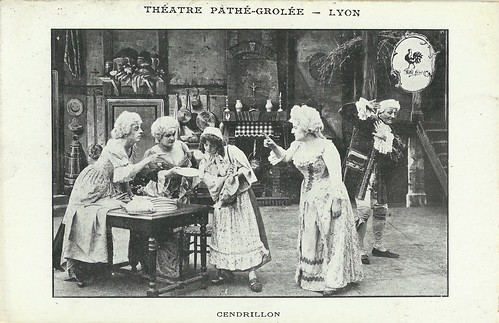
French postcard by Théâtre Pathé Grolée, Lyon. Photo: Pathé Frères. Publicity still for the fairy tale film Cendrillon, ou la Pantoufle Merveilleuse/Cinderella, or the Marvellous Slipper (Albert Capellani, 1907).
This production by Ferdinand Zecca for Pathé Frères was adapted from the Charles Perrault fairy tale.
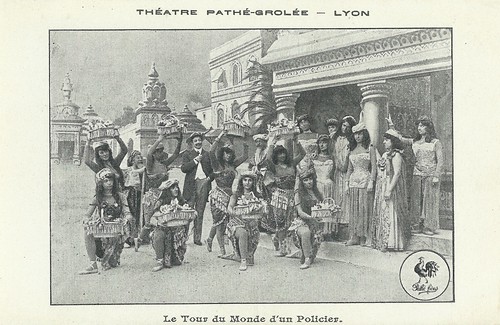
French postcard by Théâtre Pathé Grolée, Lyon. Photo: Pathé Frères. Publicity still for Le tour du monde d'un policier (Charles Lépine, 1906). Special effects by Segundo de Chomón.
Georges Vinter plays a police detective who has many adventures as he travels to Suez, Bombay, Yokohama, and the U.S.
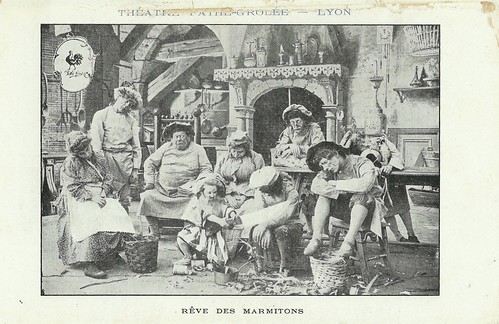
French postcard by Théâtre Pathé Grolée, Lyon. Photo: Pathé Frères. Publicity still for Rêve des marmitons (Segundo de Chomón, 1905). Special effects by Segundo de Chomón.
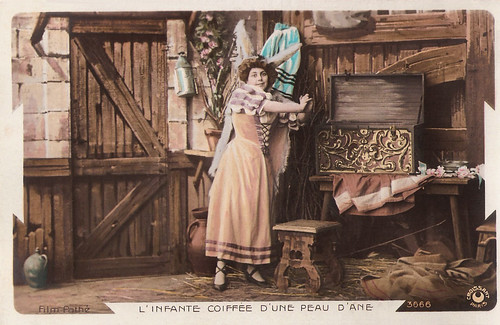
French postcard by Croissant, Paris, no. 3666. Photo: Film Pathé. Publicity still for Peau d'âne/Donkey Skin (Albert Capellani, 1908). Caption: L'infante coiffée d'une peau d'âne (The princess wears a donkey skin).
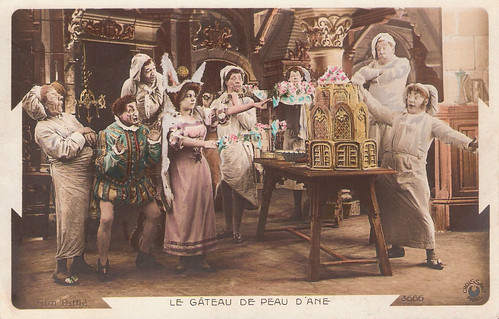
French postcard by Croissant, Paris, no. 3666. Photo: Film Pathé. Publicity still for Peau d'âne/Donkey Skin (Albert Capellani, 1908). Caption: Le Gateau de Peau d'ane (The Cake of Donkey Skin).
The early Pathé production Peau d'ane/Donkey Skin (1908, Albert Capellani) was based on a fairytale by Charles Perrault (1697). The actors are unknown.
Source: Fondation Jerome Seydoux Pathé (French).
This is a post for Postcard Friendship Friday, hosted by Beth at The Best Hearts are Crunchy. You can visit her by clicking on the button below.


French postcard by Croissant, Paris, no. 3573. Photo: Film Pathé. This is the final scene from La poule aux oeufs d'or (Gaston Velle 1905), adapted from the fable of Jean de la Fontaine. Cinematography and special effects by Segundo de Chomón.
A poor farmer wins a chicken in the lottery at the fairground. The chicken is an enchanted animal (doing a chicken dance with the other chicken girls), laying big eggs full of money. Thieves whom we already saw 'working' at the fairground, steal rabbits from the farmer. The farmer turns a rich man, but his wealth is short-lived. The thieves steal an egg but a bat flies out of it. Another egg contains a devil spitting gold and it explodes. At night the thieves witness how the farmer takes an egg to a secret cellar where he cherishes all his gold, despite nightmare visions of staring eyes and grabbing arms. After the thieves have stolen the money the creditors appear. Desperately, and inspired by a devil, the man slaughters the chicken. He finds a last egg but an evil witch comes out of it who sends him to a fairyland. There the man is led away, after which an apotheosis follows with a dance of chicken girls and fairies, emptying eggs with gold coins.

French postcard by Croissant, Paris, no. 3672. Photo: Film Pathé. Publicity still for Un drame à Venise/Venetian Tragedy (Lucien Nonguet, 1906). Sent by mail in 1917.
In this early Pathé Frères production, one of the rich palaces of Venice is the setting for a drama of smouldering love and hate. In the Middle Ages, an important lord is not loved by his wife. Despite the sumptuous wealth her husband surrounds her with, the noble dame can only think about a young and handsome Romeo. The lover is surprised by the husband, who kills him and Romeo ends in a canal. The noble lady escapes her death when her husband is stopped by her miraculous beauty... The film is partly in colour.

French postcard by Théâtre Pathé Grolée, Lyon. Photo: Pathé Frères. Publicity still for Samson moderne (N.N., 1908).
On the fairground an unknown young man manages to conquer the wrestling champion. When after a series of adventures he is imprisoned he breaks down the walls like a modern Samson. Returned home his wife celebrates him with wine but is jealous of his force, so like a modern Delila she cuts his hair off in his sleep. Awakened, the man has lost his hair and his strength.

French postcard by Théâtre Pathé Grolée, Lyon. Photo: Pathé Frères. Publicity still for La légende de Polichinelle (Albert Capellani, 1907). With Max Linder as Polichinelle.
Polichinelle is an automaton in love with a cute doll in the same shop. When the doll is sold, a fairy helps Polichinelle following her and after a series of wild adventures he arrives at the house of the buyer just in time to save the doll from being burned.

French postcard by Théâtre Pathé Grolée, Lyon. Photo: Pathé frères. Publicity still for Un crocodile cambrioleur (N.N., 1908).
Two burglars are interrupted in their job, so one hides underneath a crocodile skin. The old professor sees the dead animal moving and alarmed he leaves to find his gun. The 'reptile' flees but is hunted by the professor and his shotgun. An ever growing multitude follows the crocodile on the street. Finally the thief mounts a pipe and frightens a family taking tea, profiting from their flight to steal valuable objects, and exiting the same way as he came. Meanwhile, the mass outside shows up while our man takes off his skin. The professor shoots and all are surprised when they find just the skin and the thief gone.

French postcard by Théâtre Pathé Grolée, Lyon. Photo: Pathé Frères. Publicity still for L'ange du village (N.N., 1908).
A young girl who begs for money to help her deadly sick mother, witnesses her mother's death and goes berserk. Everywhere she goes she sees beggars whom she gives money: even in a river. She wanders fields and woods. Suddenly she sees her mother with her arms spread... and falls dead on the road.

French postcard by Théâtre Pathé Grolée, Lyon.Photo: Pathé Frères. Publicity still for L'Espionne (N.N., 1906). With Louis Pagliéri.
Vera, daughter of a Cossack loves a young tartar who is the enemy of her father. She betrays her father to save the life of her lover, but loses her own life instead.

French postcard by Théâtre Pathé Grolée, Lyon. Photo: Pathé Frères. Publicity still for the fairy tale film Cendrillon, ou la Pantoufle Merveilleuse/Cinderella, or the Marvellous Slipper (Albert Capellani, 1907).
This production by Ferdinand Zecca for Pathé Frères was adapted from the Charles Perrault fairy tale.

French postcard by Théâtre Pathé Grolée, Lyon. Photo: Pathé Frères. Publicity still for Le tour du monde d'un policier (Charles Lépine, 1906). Special effects by Segundo de Chomón.
Georges Vinter plays a police detective who has many adventures as he travels to Suez, Bombay, Yokohama, and the U.S.

French postcard by Théâtre Pathé Grolée, Lyon. Photo: Pathé Frères. Publicity still for Rêve des marmitons (Segundo de Chomón, 1905). Special effects by Segundo de Chomón.

French postcard by Croissant, Paris, no. 3666. Photo: Film Pathé. Publicity still for Peau d'âne/Donkey Skin (Albert Capellani, 1908). Caption: L'infante coiffée d'une peau d'âne (The princess wears a donkey skin).

French postcard by Croissant, Paris, no. 3666. Photo: Film Pathé. Publicity still for Peau d'âne/Donkey Skin (Albert Capellani, 1908). Caption: Le Gateau de Peau d'ane (The Cake of Donkey Skin).
The early Pathé production Peau d'ane/Donkey Skin (1908, Albert Capellani) was based on a fairytale by Charles Perrault (1697). The actors are unknown.
Source: Fondation Jerome Seydoux Pathé (French).
This is a post for Postcard Friendship Friday, hosted by Beth at The Best Hearts are Crunchy. You can visit her by clicking on the button below.

These are all wonderful, Paul. I was so fascinated by the costumes and poses. I could sit and look at these for the longest time and not get bored. I wish I could see their performances. Thank you for posting, my Friend!
ReplyDeleteGreetings from Oregon and have a great week.